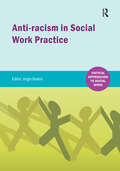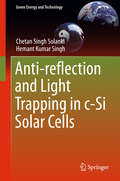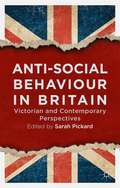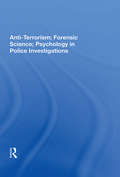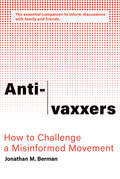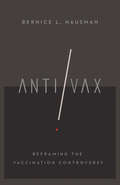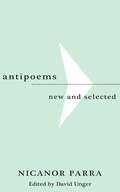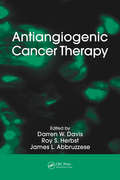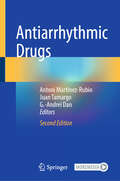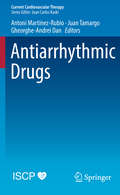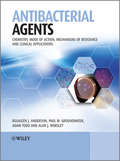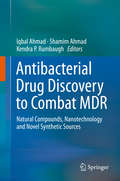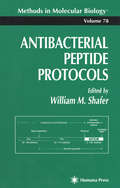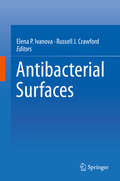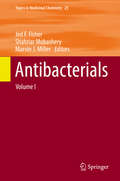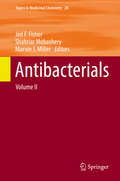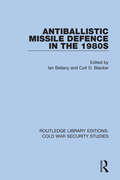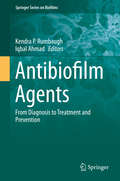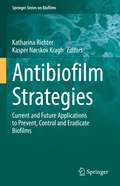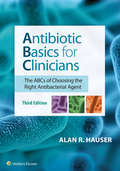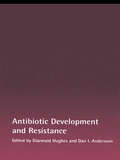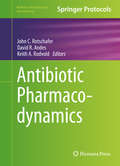- Table View
- List View
Anti-racism in Social Work practice (Critical Approaches to Social Work)
by Angie BartoliAnti-racism has a long history within the profession of social work and its education. Despite an agenda within higher education which promotes internationalization and practice which recognizes diversity, little has been written to address the question of why black African students have a different experience from others on their social work educational journey.This book is based upon the authors’ experience as educators and their own research about and with black students’ experience of racism and ‘otherness’ within social work practice and education. Radical and honest in nature, it re-visits anti-racism within social work practice and education from a student focused and informed perspective based on lived experience and conversations.This book will be of interest to all social work students, educators and policy makers with an interest in anti-racism and diversity. It includes practical models and tried and tested tools to help the reader work through these issues. Tools that can assist students in discussing uncomfortable issues in the classroom are to be welcomed, and this book is thus a valuable resource. This book offers many examples of how racism can be addressed in social work education and training. Important features of the book are the summaries of key pieces of research in each chapter, as well as, case studies and critical questions, which provide a springboard for discussion. It offers a timely reminder that discussion about race and anti-racist forms of pedagogical approaches for teaching has fallen off the agenda. It is written in an accessible style, is an engaging read, and this is a welcome addition to the literature.Dr Claudia Bernard, Goldsmiths College.
Anti-reflection and Light Trapping in c-Si Solar Cells (Green Energy and Technology)
by Hemant Kumar Singh Chetan Singh SolankiThis book offers essential insights into c-Si based solar cells and fundamentals of reflection, refraction, and light trapping. The basic physics and technology for light trapping in c-Si based solar cells are covered, from traditional to advanced light trapping structures. Further, the book discusses the latest developments in plasmonics for c-Si solar cell applications, along with their future scope and the requirements for further research. The book offers a valuable guide for graduate students, researchers and professionals interested in the latest trends in solar cell technologies.
Anti-social Behaviour in Britain
by Sarah PickardAnti-social behaviour is a key issue in the social and political life of Britain in the twenty-first century, as were respectability and immorality in the Victorian era. Written by expert sociologists, historians, criminologists and political scientists, this interdisciplinary collection examines anti-social behaviour from a range of historical and contemporary perspectives. The volume compares two essential themes, firstly the forms of anti-social behaviour and secondly the methods employed by governments to repress and control anti-social behaviour. Compelling parallels emerge through the interrelated chapters, which are divided into three main areas: the urban environment and public spaces, the vulnerable and the marginalised and recreation and leisure. This comprehensive collection is the first to examine anti-social behaviour from such an inclusive and wide-ranging position. It establishes clear parallels between the two periods regarding types of ASB and how they have been dealt with by successive governments, arguing that anti-social behaviour and political responses to it are by no means new phenomena.
Anti-terrorism, Forensic Science, Psychology In Police Investigations
by John S MajorThis book presents a broad selection of the papers presented at IDENTA '85 on various topics, including counter-terrorism; Israel's experience with terrorism; police and terrorism; and psychological methods, forensic science and voice identification in criminal investigation. The conference on International Congress on Technologies for Police Identification & Counter-Terrorism, was held in 1985 in Jerusalem.
Anti-vaxxers: How to Challenge a Misinformed Movement
by Jonathan M. BermanFrom science advocate and March on Science National Co-Chair Jonathan M. Berman, an essential takedown of the anti-vaccination movement, from its nineteenth-century antecedents to today's Facebook activists, offering strategies for refuting false claims of friends and family.Vaccines are a documented success story, one of the most successful public health interventions in history. Yet there is a vocal anti-vaccination movement, featuring celebrity activists (including Kennedy scion Robert F. Kennedy Jr. and actress Jenny McCarthy) and the propagation of anti-vax claims through books, documentaries, and social media. In Anti-Vaxxers, Jonathan Berman explores the phenomenon of the anti-vaccination movement, recounting its history from its nineteenth-century antecedents to today's activism, examining its claims, and suggesting a strategy for countering them.
Anti/Vax: Reframing the Vaccination Controversy (The Culture and Politics of Health Care Work)
by Bernice L. HausmanAntivaxxers are crazy. That is the perception we all gain from the media, the internet, celebrities, and beyond, writes Bernice Hausman in Anti/Vax, but we need to open our eyes and ears so that we can all have a better conversation about vaccine skepticism and its implications.Hausman argues that the heated debate about vaccinations and whether to get them or not is most often fueled by accusations and vilifications rather than careful attention to the real concerns of many Americans. She wants to set the record straight about vaccine skepticism and show how the issues and ideas that motivate it—like suspicion of pharmaceutical companies or the belief that some illness is necessary to good health—are commonplace in our society.Through Anti/Vax, Hausman wants to engage public health officials, the media, and each of us in a public dialogue about the relation of individual bodily autonomy to the state's responsibility to safeguard citizens' health. We need to know more about the position of each side in this important stand-off so that public decisions are made through understanding rather than stereotyped perceptions of scientifically illiterate antivaxxers or faceless bureaucrats. Hausman reveals that vaccine skepticism is, in part, a critique of medicalization and a warning about the dangers of modern medicine rather than a glib and gullible reaction to scaremongering and misunderstanding.
AntiPoems: New and Selected
by Nicanor ParraAntipoems: New and Selected, a fresh bilingual gathering as well as retrospective of the work of Chile’s foremost poet, reintroduces him to North American readers after thirteen years. Though he has been hardly unproductive, the politics of his homeland have channeled his inventiveness into new modes of expression, which remind us of the sometimes sly hermeticism of Italian writers, Eugenio Montale and Elio Vittorini among them, during the Fascist regime. As Frank MacShane makes clear in his introduction, Parra has not tried to escape repression, but by “using his wit and his humor, he has shown how the artist can still speak the truth in troubled times.” Since much of Parra’s early work is now out of print, editor David Unger has included many of the poems which influenced North American poets such as Ferlinghetti and Merton in the ‘50s and ‘60s, some in new or revised translations. Of Parra’s more recent work, there are generous selections from Artifacts (1972), Sermons and Preachings of the Christ of Elqui (1977), New Sermons and Preachings of the Christ of Elqui(1979), Jokes to Mislead the Police (1983), Ecopoems (1983), Recent Sermons(1983), and a section of “Uncollected Poems” (1984). Antipoems: New and Selected is edited by David Unger, who contributed many of the translations to Enrique Lihn’s The Dark Room and Other Poems (New Directions, 1978). Professor Frank MacShane of Columbia University, in his critical introduction, gives a full evaluation of a poet who is “unquestionably one of the most influential and accomplished in Latin America today, heir to the position long held by his countryman, Pablo Neruda.”
Antiangiogenic Cancer Therapy
by James L. Abbruzzese Roy S. Herbst Darren W. DavisTop Investigators Explore the Complexities of Angiogenesis Cancer ResearchThe targeting of tumor angiogenesis has evolved into one of the most widely pursued therapeutic strategies. However, as of yet, no antiangiogenic agent used as a monotherapy has demonstrated a survival benefit in a randomized Phase III trial. The combination of bev
Antiarrhythmic Drugs
by Antoni Martínez-Rubio Juan Tamargo G. Andrei DanThis extensively updated edition reviews current and potential future therapies for cardiac arrhythmias. Developing the highly practical format of the original, this edition provides a thorough guide for the use of pharmaceuticals in the management of the condition and is focused on providing a clinical manual for arrhythmia treatment.Antiarrhythmic Drugs builds on the current understanding of pathophysiological mechanisms and insights gained from previous studies of therapeutic interventions. It is designed to establish the baseline level of knowledge that a cardiovascular professional needs to know on a day-to-day basis.
Antiarrhythmic Drugs (Current Cardiovascular Therapy)
by Gheorghe-Andrei Dan Antoni Martínez-Rubio Juan TamargoThis volume reviews current and potential future therapies for arrhythmias. It is a highly practical guide for the use of pharmaceuticals in the management of the discipline, and has been written in a simple quick-access format.Antiarrhythmic Drugs builds on the current understanding of pathophysiological mechanisms and insights gained from previous studies of therapeutic interventions. It is designed to establish the baseline level of knowledge that a cardiovascular professional needs to know on a day-to-day basis.
Antibacterial Agents
by Paul Groundwater Rosaleen Anderson Alan Worsley Adam ToddAntibacterial agents act against bacterial infection either by killing the bacterium or by arresting its growth. They do this by targeting bacterial DNA and its associated processes, attacking bacterial metabolic processes including protein synthesis, or interfering with bacterial cell wall synthesis and function.Antibacterial Agents is an essential guide to this important class of chemotherapeutic drugs. Compounds are organised according to their target, which helps the reader understand the mechanism of action of these drugs and how resistance can arise. The book uses an integrated "lab-to-clinic" approach which covers drug discovery, source or synthesis, mode of action, mechanisms of resistance, clinical aspects (including links to current guidelines, significant drug interactions, cautions and contraindications), prodrugs and future improvements.Agents covered include:agents targeting DNA - quinolone, rifamycin, and nitroimidazole antibacterial agentsagents targeting metabolic processes - sulfonamide antibacterial agents and trimethoprimagents targeting protein synthesis - aminoglycoside, macrolide and tetracycline antibiotics, chloramphenicol, and oxazolidinonesagents targeting cell wall synthesis - β-Lactam and glycopeptide antibiotics, cycloserine, isonaizid, and daptomycinAntibacterial Agents will find a place on the bookshelves of students of pharmacy, pharmacology, pharmaceutical sciences, drug design/discovery, and medicinal chemistry, and as a bench reference for pharmacists and pharmaceutical researchers in academia and industry.
Antibacterial Drug Discovery to Combat MDR: Natural Compounds, Nanotechnology and Novel Synthetic Sources
by Iqbal Ahmad Kendra P. Rumbaugh Shamim AhmadThis book compiles the latest information in the field of antibacterial discovery, especially with regard to the looming threat of multi-drug resistance. The respective chapters highlight the discovery of new antibacterial and anti-infective compounds derived from microbes, plants, and other natural sources. The potential applications of nanotechnology to the fields of antibacterial discovery and drug delivery are also discussed, and one section of the book is dedicated to the use of computational tools and metagenomics in antibiotic drug discovery. Techniques for efficient drug delivery are also covered. The book provides a comprehensive overview of the progress made in both antibacterial discovery and delivery, making it a valuable resource for academic researchers, as well as those working in the pharmaceutical industry.
Antibacterial Peptide Protocols (Methods in Molecular Biology #78)
by William ShaferLeading experts review for the first time in one volume all the mjaor biochemical, molecular, bacteriological, and physical techniques available to assess antimicrobial peptides. These state-of-the-art methods ensure easily reproducible results in such important procedures as the isolation and characterization of antimicrobial peptides, the molecular characterization of genes encoding antimicrobial peptides, and the use of expression systems to isolate peptides. Bioassays and microbial genetic techniques are also included, as are antibacterial assays as the final readout system.
Antibacterial Surfaces
by Elena Ivanova Russell Crawford'Antibacterial Surfaces' covers the advances being made in the design of antibacterial surfaces, which have the ability to either prevent the initial attachment of bacterial cells, or kill any cells that come into contact with these surfaces. This book discusses the mechanisms associated with the attachment of bacteria to surfaces and the main strategies currently being employed to control the initial attachment processes. These strategies are expanded upon in the subsequent chapters, where the definition and description of antibacterial surfaces are clarified, as are the mechanisms that come into play when determining the effectiveness of an antibacterial surface. Subsequent chapters discuss a number of naturally occurring antibacterial surfaces, the methods currently being used for producing synthetic antibacterial surfaces, and the current and potential applications of such materials. This book will be of great interest to people who work with materials that need to remain free of bacterial films, from designing safer biomedical implants to the production of self-cleaning materials where the prevention of biofilm formation has significant economic advantages.
Antibacterials: Volume I (Topics in Medicinal Chemistry #25)
by Jed F. Fisher Shahriar Mobashery Marvin J. MillerMedicinal chemistry is both science and art. The science of medicinal chemistry offers mankind one of its best hopes for improving the quality of life. The art of medicinal chemistry continues to challenge its practitioners with the need for both intuition and experience to discover new drugs. Hence sharing the experience of drug research is uniquely beneficial to the field of medicinal chemistry. Drug research requires interdisciplinary team-work at the interface between chemistry, biology and medicine. Therefore, the topic-related series Topics in Medicinal Chemistry covers all relevant aspects of drug research, e.g. pathobiochemistry of diseases, identification and validation of (emerging) drug targets, structural biology, drugability of targets, drug design approaches, chemogenomics, synthetic chemistry including combinatorial methods, bioorganic chemistry, natural compounds, high-throughput screening, pharmacological in vitro and in vivo investigations, drug-receptor interactions on the molecular level, structure-activity relationships, drug absorption, distribution, metabolism, elimination, toxicology and pharmacogenomics. In general, special volumes are edited by well known guest editors
Antibacterials: Volume II (Topics in Medicinal Chemistry #26)
by Jed F. Fisher Shahriar Mobashery Marvin J. MillerMedicinal chemistry is both science and art. The science of medicinal chemistry offers mankind one of its best hopes for improving the quality of life. The art of medicinal chemistry continues to challenge its practitioners with the need for both intuition and experience to discover new drugs. Hence sharing the experience of drug research is uniquely beneficial to the field of medicinal chemistry. Drug research requires interdisciplinary team-work at the interface between chemistry, biology and medicine. Therefore, the topic-related series Topics in Medicinal Chemistry covers all relevant aspects of drug research, e.g. pathobiochemistry of diseases, identification and validation of (emerging) drug targets, structural biology, drugability of targets, drug design approaches, chemogenomics, synthetic chemistry including combinatorial methods, bioorganic chemistry, natural compounds, high-throughput screening, pharmacological in vitro and in vivo investigations, drug-receptor interactions on the molecular level, structure-activity relationships, drug absorption, distribution, metabolism, elimination, toxicology and pharmacogenomics. In general, special volumes are edited by well known guest editors
Antiballistic Missile Defence in the 1980s (Routledge Library Editions: Cold War Security Studies #2)
by Ian Bellany; Coit D. BlackerThis book, first published in 1983, analyses the technical and political developments in the two decades after the 1972 Soviet-American ABM treaty. It signposts the route for discussion of the antiballistic missile question – with its shared tacit assumption that nuclear war is for deterring and not fighting – and examines the dangerous tendency to conduct the ABM debate of the 1980s with the technical and political assumptions of the 1960s.
Antibiofilm Agents: From Diagnosis to Treatment and Prevention (Springer Series on Biofilms #8)
by Iqbal Ahmad Kendra P. RumbaughThis book provides a survey of recent advances in the development of antibiofilm agents for clinical and environmental applications. The fact that microbes exist in structured communities called biofilms has slowly become accepted within the medical community. We now know that over 80% of all infectious diseases are biofilm-related; however, significant challenges still lie in our ability to diagnose and treat these extremely recalcitrant infections. Written by experts from around the globe, this book offers a valuable resource for medical professionals seeking to treat biofilm-related disease, academic and industry researchers interested in drug discovery and instructors who teach courses on microbial pathogenesis and medical microbiology.
Antibiofilm Strategies: Current and Future Applications to Prevent, Control and Eradicate Biofilms (Springer Series on Biofilms #11)
by Katharina Richter Kasper Nørskov KraghBacteria and fungi are able to aggregate together or on surfaces in densely packed microcolonies, facilitated by extracellular polymeric substances for cell protection and stability. These biofilms have proven to be extremely hard to eradicate and remove once established. In chronic infections, this condition can result in a high degree of morbidity and mortality as regular antibiotic treatments are ineffective against biofilms. In industrial facilities, the formation of biofilms can ruin production and result in enormous financial losses. In this book, the current state of antibiofilm research is presented by experts from around the world. Novel, cutting-edge techniques and new optimized strategies based on established methods are discussed in chapters focused on biofilm prevention, treatment and control for the application in clinical, industrial and veterinary settings. Antibiofilm strategies, such as chemical and enzymatic treatments, surface modification and coatings, quorum sensing inhibition and dispersal induction, phage therapy, cold plasma treatment, hyperbaric oxygen treatment, and metal-based nanomedicine are covered, among many others. This book contributes to the UN’s Sustainable Development Goal 3: Good Health and Well-Being and is a valuable resource for healthcare professionals, microbiologists, academics and for educators to inform curricula of universities and colleges.
Antibiotic Basics for Clinicians: The Abcs Of Choosing The Right Antibacterial Agent (Point (lippincott Williams And Wilkins) Ser.)
by Alan HauserPublisher's Note: Products purchased from 3rd Party sellers are not guaranteed by the Publisher for quality, authenticity, or access to any online entitlements included with the product. Popular as a classroom text, for review, and as a clinical quick-reference, this time-saving resource helps medical students master the rationale behind antibiotic selection for common bacterial pathogens and infectious diseases. Updated content reflects the latest antibiotic medications available on the market, and new full-color illustrations strengthen users’ understanding of the application of antibiotic drug treatment.
Antibiotic Development and Resistance
by Diarmaid Hughes Dan I. AnderssonThe increasing resistance of bacteria towards all current classes of antibiotics is now a serious health problem in both developed and developing countries. Antibiotic Development and Resistance presents 15 chapters that explore the medical issues raised by this development and review the relevant literature. The book begins by reviewing the global
Antibiotic Discovery and Development
by Michael J. Pucci Thomas J. DoughertyThis volume covers all aspects of the antibiotic discovery and development process through Phase II/III. The contributors, a group of highly experienced individuals in both academics and industry, include chapters on the need for new antibiotic compounds, strategies for screening for new antibiotics, sources of novel synthetic and natural antibiotics, discovery phases of lead development and optimization, and candidate compound nominations into development. Beyond discovery , the handbook will cover all of the studies to prepare for IND submission: Phase I (safety and dose ranging), progression to Phase II (efficacy), and Phase III (capturing desired initial indications). This book walks the reader through all aspects of the process, which has never been done before in a single reference. With the rise of antibiotic resistance and the increasing view that a crisis may be looming in infectious diseases, there are strong signs of renewed emphasis in antibiotic research. The purpose of the handbook is to offer a detailed overview of all aspects of the problem posed by antibiotic discovery and development.
Antibiotic Drug Resistance
by José‐Luis Capelo‐Martínez Gilberto IgrejasThis book presents a thorough and authoritative overview of the multifaceted field of antibiotic science – offering guidance to translate research into tools for prevention, diagnosis, and treatment of infectious diseases. Provides readers with knowledge about the broad field of drug resistance Offers guidance to translate research into tools for prevention, diagnosis, and treatment of infectious diseases Links strategies to analyze microbes to the development of new drugs, socioeconomic impacts to therapeutic strategies, and public policies to antibiotic-resistance-prevention strategies
Antibiotic Optimization: Concepts and Strategies in Clinical Practice (Infectious Disease And Therapy Ser. #Vol. 34)
by Jr. Robert C. Owens Paul G. Ambrose Charles H. NightingaleThis book focuses on topics ranging from the economics of drug-resistant infections and the management of antimicrobial use to new information on methods to optimize the selection, route of administration, dosing, and duration of antimicrobial therapies for common infections. In addition to offering ideas on studied programmatic approaches for judi
Antibiotic Pharmacodynamics (Methods in Pharmacology and Toxicology)
by Keith A. Rodvold John C. Rotschafer David R. AndesThis text offers state of the art contributions written by world renown experts which provide an extensive background on specific classes of antibiotics and summarize our understanding as to how these antibiotics might be optimally used in a clinical situation. The book explores pharmacodynamics methods for anti-infective agents, pharmacodynamics of antibacterial agents and non-antibacterial agents, as well as pharmacodynamic considerations and special populations. As part of the Methods in Pharmacology and Toxicology series, chapters include detailed insight and practical information for the lab. Comprehensive and cutting-edge, Antibiotic Pharmacodynamics serves as an ideal reference for scientists investigating advances in antibiotic pharmacodynamics now finding their way into the antibiotic development process used for licensing new antibiotics.
